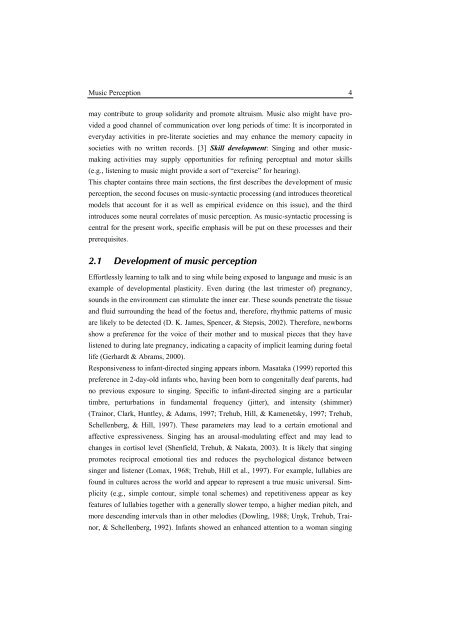Neural Correlates of Processing Syntax in Music and ... - PubMan
Neural Correlates of Processing Syntax in Music and ... - PubMan
Neural Correlates of Processing Syntax in Music and ... - PubMan
You also want an ePaper? Increase the reach of your titles
YUMPU automatically turns print PDFs into web optimized ePapers that Google loves.
<strong>Music</strong> Perception 4<br />
may contribute to group solidarity <strong>and</strong> promote altruism. <strong>Music</strong> also might have provided<br />
a good channel <strong>of</strong> communication over long periods <strong>of</strong> time: It is <strong>in</strong>corporated <strong>in</strong><br />
everyday activities <strong>in</strong> pre-literate societies <strong>and</strong> may enhance the memory capacity <strong>in</strong><br />
societies with no written records. [3] Skill development: S<strong>in</strong>g<strong>in</strong>g <strong>and</strong> other musicmak<strong>in</strong>g<br />
activities may supply opportunities for ref<strong>in</strong><strong>in</strong>g perceptual <strong>and</strong> motor skills<br />
(e.g., listen<strong>in</strong>g to music might provide a sort <strong>of</strong> “exercise” for hear<strong>in</strong>g).<br />
This chapter conta<strong>in</strong>s three ma<strong>in</strong> sections, the first describes the development <strong>of</strong> music<br />
perception, the second focuses on music-syntactic process<strong>in</strong>g (<strong>and</strong> <strong>in</strong>troduces theoretical<br />
models that account for it as well as empirical evidence on this issue), <strong>and</strong> the third<br />
<strong>in</strong>troduces some neural correlates <strong>of</strong> music perception. As music-syntactic process<strong>in</strong>g is<br />
central for the present work, specific emphasis will be put on these processes <strong>and</strong> their<br />
prerequisites.<br />
2.1 Development <strong>of</strong> music perception<br />
Effortlessly learn<strong>in</strong>g to talk <strong>and</strong> to s<strong>in</strong>g while be<strong>in</strong>g exposed to language <strong>and</strong> music is an<br />
example <strong>of</strong> developmental plasticity. Even dur<strong>in</strong>g (the last trimester <strong>of</strong>) pregnancy,<br />
sounds <strong>in</strong> the environment can stimulate the <strong>in</strong>ner ear. These sounds penetrate the tissue<br />
<strong>and</strong> fluid surround<strong>in</strong>g the head <strong>of</strong> the foetus <strong>and</strong>, therefore, rhythmic patterns <strong>of</strong> music<br />
are likely to be detected (D. K. James, Spencer, & Stepsis, 2002). Therefore, newborns<br />
show a preference for the voice <strong>of</strong> their mother <strong>and</strong> to musical pieces that they have<br />
listened to dur<strong>in</strong>g late pregnancy, <strong>in</strong>dicat<strong>in</strong>g a capacity <strong>of</strong> implicit learn<strong>in</strong>g dur<strong>in</strong>g foetal<br />
life (Gerhardt & Abrams, 2000).<br />
Responsiveness to <strong>in</strong>fant-directed s<strong>in</strong>g<strong>in</strong>g appears <strong>in</strong>born. Masataka (1999) reported this<br />
preference <strong>in</strong> 2-day-old <strong>in</strong>fants who, hav<strong>in</strong>g been born to congenitally deaf parents, had<br />
no previous exposure to s<strong>in</strong>g<strong>in</strong>g. Specific to <strong>in</strong>fant-directed s<strong>in</strong>g<strong>in</strong>g are a particular<br />
timbre, perturbations <strong>in</strong> fundamental frequency (jitter), <strong>and</strong> <strong>in</strong>tensity (shimmer)<br />
(Tra<strong>in</strong>or, Clark, Huntley, & Adams, 1997; Trehub, Hill, & Kamenetsky, 1997; Trehub,<br />
Schellenberg, & Hill, 1997). These parameters may lead to a certa<strong>in</strong> emotional <strong>and</strong><br />
affective expressiveness. S<strong>in</strong>g<strong>in</strong>g has an arousal-modulat<strong>in</strong>g effect <strong>and</strong> may lead to<br />
changes <strong>in</strong> cortisol level (Shenfield, Trehub, & Nakata, 2003). It is likely that s<strong>in</strong>g<strong>in</strong>g<br />
promotes reciprocal emotional ties <strong>and</strong> reduces the psychological distance between<br />
s<strong>in</strong>ger <strong>and</strong> listener (Lomax, 1968; Trehub, Hill et al., 1997). For example, lullabies are<br />
found <strong>in</strong> cultures across the world <strong>and</strong> appear to represent a true music universal. Simplicity<br />
(e.g., simple contour, simple tonal schemes) <strong>and</strong> repetitiveness appear as key<br />
features <strong>of</strong> lullabies together with a generally slower tempo, a higher median pitch, <strong>and</strong><br />
more descend<strong>in</strong>g <strong>in</strong>tervals than <strong>in</strong> other melodies (Dowl<strong>in</strong>g, 1988; Unyk, Trehub, Tra<strong>in</strong>or,<br />
& Schellenberg, 1992). Infants showed an enhanced attention to a woman s<strong>in</strong>g<strong>in</strong>g












